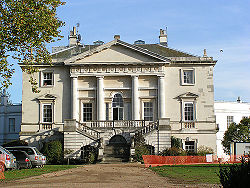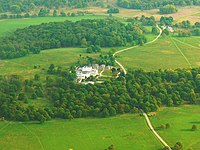White Lodge, Richmond Park
| White Lodge | |
| Surrey | |
|---|---|
 White Lodge, Richmond Park | |
| Location | |
| Grid reference: | TQ20687323 |
| Location: | 51°26’43"N, 0°15’53"W |
| Village: | Richmond Park |
| History | |
| Built 1727 – 1730 | |
| For: | King George II by Roger Morris |
| Information | |
White Lodge is a Georgian house standing in Richmond Park, in Surrey. Formerly a royal residence, it now houses the Royal Ballet Lower School, instructing students aged 11–16.
The lodge is a Grade I listed building.[1]
Early history

The house was built as a hunting lodge for King George II, by the architect Roger Morris: construction began shortly after the King's accession to the throne in 1727 and it was completed in 1730. Originally the house was called Stone Lodge: it was renamed New Lodge shortly afterwards to distinguish itself from nearby Old Lodge,[2] which itself had been built by George II.[3] for Britain's first prime minister, Sir Robert Walpole, who frequented it, particularly to hunt at the estate. Walpole said that he could "do more business there (Old Lodge) than he could in town".[4][5]
Caroline of Ansbach, wife of George II, stayed at the new lodge frequently and, on her death in 1737, White Lodge passed to Walpole. After his death, it passed to Queen Caroline's daughter, Princess Amelia, in 1751. Amelia also became the ranger of Richmond Park and closed the entire park to the public, except to distinguished friends and those with permits, sparking public outrage.[6] In 1758, a court case made by a local brewer against a park gatekeeper eventually overturned Princess Amelia's order, and the park was once again opened to the public.[6] Amelia is remembered for adding the two white wings to the main lodge, which remain to this day. They were designed by Stephen Wright.[7][8]
John Stuart, 3rd Earl of Bute, then Prime Minister, became ranger of Richmond Park after Princess Amelia's resignation in 1760.[9] The British Magazine for January 1761 lists Lord Bute as the Ranger with his Deputy Ranger being Sir Sidney Meadows (d.1792).[10] Although White Lodge remained Lord Bute's official address, he was also entitled to the use of White Lodge's neighbour, Old Lodge, which would house the Meadows family, who were of the Prime Minister's extended family: Sir Philip's wife, Lady Frances Meadows, née Pierrepont, was the first cousin of the prime minister's wife, Mary Stuart Wortley.[11][12] (The Old Lodge was demolished in 1841.)
It was during the Bute-Meadows period that the name White Lodge first appeared, in the journal of Lady Mary Coke. In her entry for Sunday 24 July 1768 she says that she went to Richmond Park hoping to catch a glimpse of King George III and Queen Charlotte, "tho' they are always at the White Lodge on a Sunday".[7]
After restoration of the house following disrepair at the close of the 18th century, George III gave the house to another prime minister, Henry Addington, 1st Viscount Sidmouth, who enclosed the lodge's first private gardens in 1805. The King made himself ranger, and Lord Sidmouth was made deputy ranger. On 10 September 1805, six weeks before the Battle of Trafalgar, Horatio Nelson, 1st Viscount Nelson, visited Lord Sidmouth at White Lodge and is said to have explained his battle plan to him there.[7]
19th and 20th centuries
After Viscount Sidmouth died in 1844, Queen Victoria gave the house to her aunt – the last surviving daughter of George III – Princess Mary, Duchess of Gloucester and Edinburgh. After her death in 1857, Prince Albert decided on White Lodge as a suitable secluded location for his son the Prince of Wales, the future Edward VII of the United Kingdom, during his minority and education. Although the Prince of Wales favoured stimulating company to hard study, Prince Albert kept him here in seclusion, with only five companions, two of whom were tutors, the Reverend Charles Feral Tarver, his Latin tutor and chaplain and Frederick Waymouth Gibbs. Understandably, the Prince of Wales found the few years at White Lodge boring.
After Queen Victoria's death in 1901, the Lodge was occupied by Eliza Emma Hartmann, a wealthy widow prominent in London society,[13] who was declared bankrupt in 1909. The house returned to royal use in 1923, during the honeymoon of Prince Albert, Duke of York, the future George VI, and the Duchess of York. Queen Mary, who had lived at White Lodge with her mother, Princess Mary Adelaide, insisted that they make their home at the Lodge. In 1924, Prince Alexander of Yugoslavia, son of the Yorks' friends Prince Paul of Yugoslavia and Princess Olga of Greece and Denmark, was born at the house during the stay of his mother there. The duke and the duchess remained in the house until late in 1925 after which the building was leased out by the Crown Estate and was occupied by various private residents, the last being Colonel James Veitch, who lived at White Lodge until 1954.[7]
Royal Ballet School
In 1955, the Sadler's Wells Ballet School was granted the use of White Lodge on a permanent basis. The school was later granted a Royal Charter and became the Royal Ballet School in 1956. It is now recognised as one of the leading ballet schools in the world.
As part of its redevelopment programme, the Royal Ballet School relocated and enlarged its ballet museum to include a gallery and collections relating to the history of White Lodge.
Outside links
References
- ↑ National Heritage List 1250045: White Lodge (Grade I listing)
- ↑ Cloake, John (1996). Palaces and Parks of Richmond and Kew, vol.II. London: Phillimore & Co Ltd. p. 105. ISBN 978-1860770234.
- ↑ Plaidy, Jean (2012). Queen Caroline – Georgian Series. Random House. ISBN 9781448150403. https://books.google.com/books?id=WhcEthm02t8C&pg=PT19.
- ↑ Cloake, John (1995). Palaces and Parks of Richmond and Kew. Phillimore. ISBN 9781860770234. https://books.google.com/books?id=DAcXAQAAIAAJ.
- ↑ Brady, John Henry (1838). A new pocket guide to London and its environs. Parker. p. 495. https://archive.org/details/anewpocketguide00unkngoog. Retrieved 15 April 2016.
- ↑ 6.0 6.1 Lankester, Max (2011). Guide to Richmond Park: History. London: Friends of Richmond Park. pp. 85–87. ISBN 978-0-9567469-0-0.
- ↑ 7.0 7.1 7.2 7.3 White Lodge, Richmond Park: Richmond Libraries Local studies collection
- ↑ "White Lodge (New Lodge) (Stone Lodge)". The DiCamillo Companion to British and Irish Country Houses. http://www.dicamillocompanion.com/houses_detail.asp?ID=1459.
- ↑ "The Biographical Magazine: Containing Portraits of Eminent ...(Earl of Bute)". London. 1816. https://books.google.com/books?id=LDIDAAAAYAAJ&pg=PA16-IA8.
- ↑ Smolette, T G (1761). "London Magazine – Promotions". James Rivington & James Fletcher. p. 335. https://books.google.com/books?id=_jIJAAAAQAAJ&pg=PA335. "Promotions Lord Bute Ranger Richmond Park Sidney Meadows Deputy Ranger Richmond Park"
- ↑ "The Lodge in Richmond Park, the residence of Philip Meadows Esq. – After George Barret (c. 1767–1842)". Royal Collection Trust. https://www.royalcollection.org.uk/collection/703027/the-lodge-in-richmond-park-the-residence-of-philip-meadows.
- ↑ Glover, Stephen (1829). "The History of the County of Derby: Drawn Up from Actual Observation, and from the Best Authorities; Containing a Variety of Geological, Mineralogical, Commercial, and Statistical Information, Volume 2, Part 1". Stephen Glover, publisher. p. 100. https://books.google.com/books?id=LtwyAQAAMAAJ&pg=PA100.
- ↑ "Lady's failure. Mrs. Eliza Hartman, Society Leader, of White Lodge". The Straits Times (Singapore): pp. 5. 29 October 1909. http://eresources.nlb.gov.sg/newspapers/Digitised/Article/straitstimes19091029-1.2.22.aspx.
- McDowall, David. Richmond Park: The Walker's Historical Guide. 2nd revised edition, 2006. 192pp. ISBN 978-0952784746
- Jackson, Joanna. A Year in the Life of Richmond Park. Frances Lincoln Publishers. 2003. 112pp. ISBN 978-0711222182
- Fletcher Jones, Pamela. Richmond Park: Portrait of a Royal Playground. Bentalls. 3rd revised edition, 1996. 48pp. ISBN 978-0952653752
- 'Richmond Libraries Local Studies Collection: Local history notes: White Lodge, Richmond Park': London Borough of Richmond upon Thames